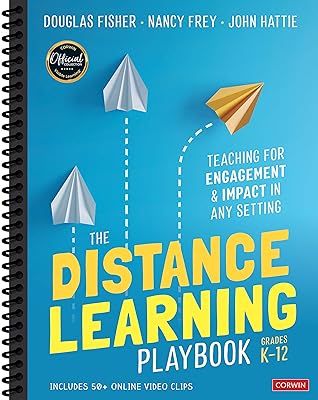Kindle Notes & Highlights
Read between
July 17 - July 21, 2020
Teachers are amazing and the public is realizing this in substantial ways. Unlike parents with a couple of kids in their homes, teachers have twenty to forty students at once. These educators can motivate students (mostly) to engage in activities that make the struggle of learning joyful. Teachers provide feedback at the right time and in the right way to each student and teachers do not “do” the work for the students. Teachers know where to go next and how to balance the breadth and depth of the ever-varied school curriculum. They utilize their know-how to invest in the after schoolwork of
...more
To be clear, the pandemic teaching of 2020 was really not distance learning. It was also not homeschooling, which is a choice parents make for very specific reasons (e.g., religious, safety, not happy with their public school). It was crisis teaching.
Perhaps you’re surprised that we start a book about distance learning with the recommendation that you need to take care of yourself. But hear us out. If you burn out, if you become exhausted and overwhelmed, you’re no good to your students (much less your family, friends, let alone yourself). The vast majority of us did not sign up for this type of teaching. We had images of ourselves arriving at a school building to be greeted by the faces of eager learners who could not wait to see us. There would be start times, breaks (called passing periods and recess), lunches, conversations with
...more
teachers model behaviors that students mimic. When we model healthy, growth-producing relationships, students see how they work. When we model respect, kindness, and a range of emotions, students notice how we regulate and respond. But even more importantly, we believe, is the opportunity to help adults continue their social and emotional learning journey and become happier, healthier members of the community, both at school and in the wider community.
scheduled breaks in her day that mirror the schedule she had previously. She takes twenty minutes midmorning for recess, forty-five minutes for lunch, and then a short stretch break in the afternoon. She ends her workday by sending a summary email to her students, thanking them for their work for the day and reminding them about the learning for the next day. Ms. Cardenas also has a routine for the end of her day, which is to either read or meditate.
Committing a thoughtful and well-constructed plan to paper is a first step in a proactive approach to distance learning and can prevent problems from emerging. It can also be a tool for you to decide in advance of a situation how you will respond. Being proactive, not reactive, is key to good classroom management. Classrooms without a classwide approach to learning have more instances of negative student–teacher interactions and less time spent on academic instruction
Once the classroom management plan has been constructed, you can produce a child-friendly version for students and families. Post this on your learning management system (LMS) and share it digitally with families. This is recommended for two reasons: It serves as an initial means for welcoming students and families at the beginning of the year, and it can become a tool for discussion when a difficulty does arise with a specific student.
Whether face-to-face instruction proceeded distance learning, or whether you are meeting students for the first time, consider the norms you want your students and yourself to embody.
The norms you create for your virtual classroom space become the foundation for the agreements you want to use. These agreements are an essential component for managing a smooth-running learning environment. Well-crafted agreements communicate the teacher’s expectations for the class as it relates to climate and student performance. It is important to note that once created, agreements must be explicitly taught to students. Two studies of efficient elementary and middle school classrooms found that in all cases the teachers taught the rules daily during the first week of school using
...more
A fewer number, rather than more, works better. The recommendation is about 3 to 5. • Co-construct them with students. That’s why we call them agreements. Even young students have a good sense of what is right and fair. • State them positively. Beware of a list of agreements that all begin with the word “No” because these do not tell students what they should do, only what they should not. Behavior cannot exist in a vacuum, and in the absence of clear statements students are left to speculate about what is acceptable. • Make them specific in nature. Agreements that are specific in nature state
...more
Teach and rehearse the expectations. This is a critical component for ensuring an efficient virtual classroom. The agreements should be taught during each distance learning session during the first week of school and revisited occasionally throughout the remainder of the year, especially after school breaks. The teacher should model each rule so that students can learn what they look and sound like. For example, if one of the agreements is about written communication on discussion boards, model examples of how these are done in ways that are respectful and academically appropriate.


